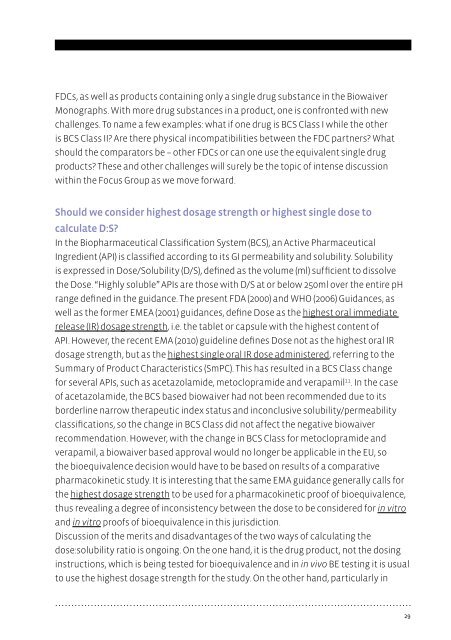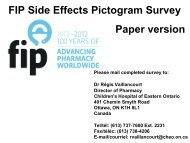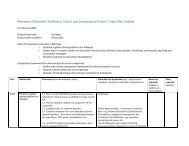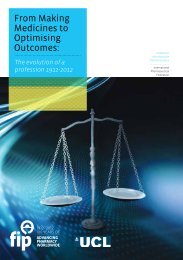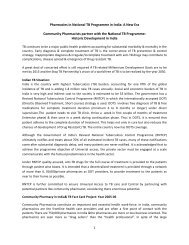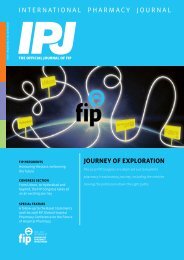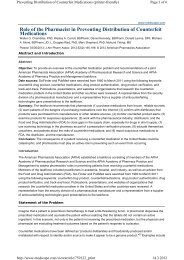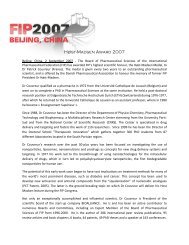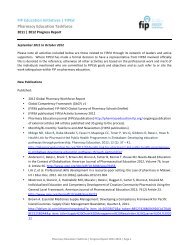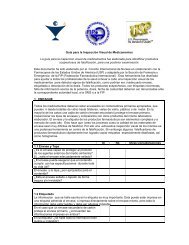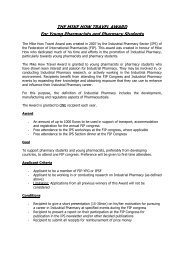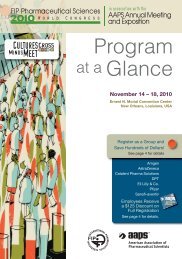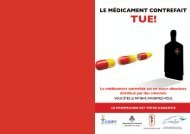THe BIOWaIVer MONOGraPHS - FIP
THe BIOWaIVer MONOGraPHS - FIP
THe BIOWaIVer MONOGraPHS - FIP
Create successful ePaper yourself
Turn your PDF publications into a flip-book with our unique Google optimized e-Paper software.
FDCs, as well as products containing only a single drug substance in the Biowaiver<br />
Monographs. With more drug substances in a product, one is confronted with new<br />
challenges. To name a few examples: what if one drug is BCS Class I while the other<br />
is BCS Class II? Are there physical incompatibilities between the FDC partners? What<br />
should the comparators be – other FDCs or can one use the equivalent single drug<br />
products? These and other challenges will surely be the topic of intense discussion<br />
within the Focus Group as we move forward.<br />
Should we consider highest dosage strength or highest single dose to<br />
calculate D:S?<br />
In the Biopharmaceutical Classification System (BCS), an Active Pharmaceutical<br />
Ingredient (API) is classified according to its GI permeability and solubility. Solubility<br />
is expressed in Dose/Solubility (D/S), defined as the volume (ml) sufficient to dissolve<br />
the Dose. “Highly soluble” APIs are those with D/S at or below 250ml over the entire pH<br />
range defined in the guidance. The present FDA (2000) and WHO (2006) Guidances, as<br />
well as the former EMEA (2001) guidances, define Dose as the highest oral immediate<br />
release (IR) dosage strength, i.e. the tablet or capsule with the highest content of<br />
API. However, the recent EMA (2010) guideline defines Dose not as the highest oral IR<br />
dosage strength, but as the highest single oral IR dose administered, referring to the<br />
Summary of Product Characteristics (SmPC). This has resulted in a BCS Class change<br />
for several APIs, such as acetazolamide, metoclopramide and verapamil 11 . In the case<br />
of acetazolamide, the BCS based biowaiver had not been recommended due to its<br />
borderline narrow therapeutic index status and inconclusive solubility/permeability<br />
classifications, so the change in BCS Class did not affect the negative biowaiver<br />
recommendation. However, with the change in BCS Class for metoclopramide and<br />
verapamil, a biowaiver based approval would no longer be applicable in the EU, so<br />
the bioequivalence decision would have to be based on results of a comparative<br />
pharmacokinetic study. It is interesting that the same EMA guidance generally calls for<br />
the highest dosage strength to be used for a pharmacokinetic proof of bioequivalence,<br />
thus revealing a degree of inconsistency between the dose to be considered for in vitro<br />
and in vitro proofs of bioequivalence in this jurisdiction.<br />
Discussion of the merits and disadvantages of the two ways of calculating the<br />
dose:solubility ratio is ongoing. On the one hand, it is the drug product, not the dosing<br />
instructions, which is being tested for bioequivalence and in in vivo BE testing it is usual<br />
to use the highest dosage strength for the study. On the other hand, particularly in<br />
29


